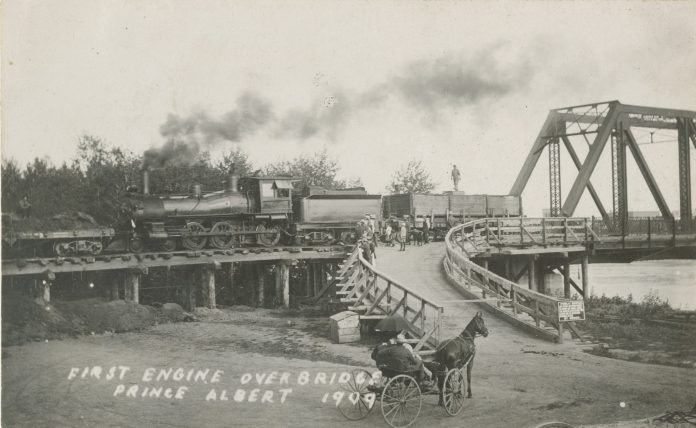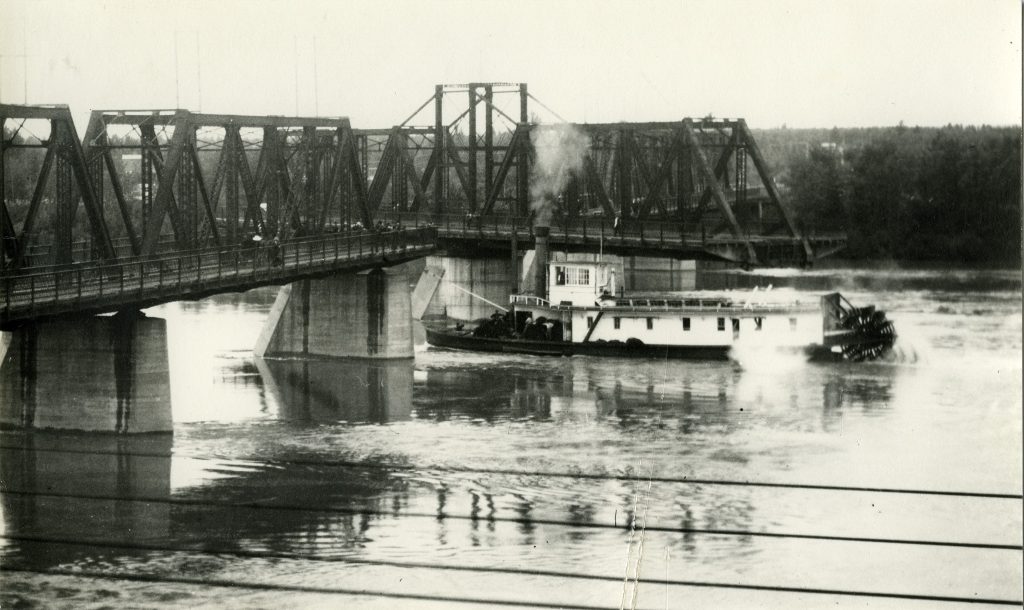
Until the completion of the Canadian Northern Railway bridge across the North Saskatchewan River in April 1909, there were limited options for Prince Albertans for travel between the north and south banks of the river. During the winter, one could cross on the river ice, but in the spring, summer, and autumn, it was necessary to use the cable ferry, which had a southern point near 1st Avenue West, or to travel by canoe or boat.
The earliest transportation routes were, of course, the rivers. Fur traders brought their goods from the east via the rivers, and returned with their furs via the same routes. Later, as settlers moved into what is now Western Canada, railways became the primary source of transportation, providing access to eastern markets for the local products, such as wheat and lumber. As a result, attracting a railway into a settlement gave the community political and economic power.
The earliest development of the railway system in Western Canada, between 1882 and 1893, included the Canadian Pacific Railway line through Saskatchewan to British Columbia, as well as the construction of several small branch lines such as the Qu’Appelle, Long Lake and Saskatchewan Railway.
This was followed by a boom in rail line construction from 1898 to 1913, with expansion including the Canadian Northern Railway and Grand Trunk Pacific Railway. Further expansion occurred after the First World War, when the Canadian Pacific Railway and the Canadian National Railway (which had absorbed the bankrupt Grand Trunk Pacific Railway and the Canadian Northern Railway) entered into rivalry developing branch lines, particularly in northern Saskatchewan.
Up to 1874, steamboats were required to provide the necessary travel between Prince Albert, Battleford, and Edmonton. With the arrival in 1890 of the Qu’Appelle, Long Lake and Saskatchewan rail lines, which originated in Regina and travelled through Saskatoon, dependence on these steamboats was considerably reduced. Initially leased to the Canadian Pacific, the line was purchased by the Canadian Northern in July, 1906.
Formed January 13, 1899 through the amalgamation of the Winnipeg Great Northern Railway and the Lake Manitoba Railway and Canal Company, a charter was granted based on extending the line from Swan Lake to Prince Albert. It was impossible to complete that task within two years as construction got bogged down in the muskeg and heavy bush west of Red Deer Lake in Manitoba. The line to Prince Albert was surveyed by June, 1902, and by June 1903, plans were announced for a combined railway and traffic bridge across the North Saskatchewan at Prince Albert. However, by February 1904, the Canadian Northern tracks had reached only Melfort.
By 1907, it was apparent that the ferry across the river was no longer adequate to meet the needs of the city of Prince Albert and area, and that a traffic bridge was essential to serve the expanding population, both on the south and the northern sides. In April of that year, the provincial government announced plans to build a traffic bridge if the Canadian Northern did not build a combination bridge. Given the desire of the provincial government to have a rail line to the Battlefords, they offered support to the Canadian Northern should the rail company push that line through quickly. With no response from that company by July, the provincial government committed $60,000 towards the construction of a separate traffic bridge.
A month later, in August 1907, a telegram was received from the Canadian Northern agreeing to the construction of a joint railway and traffic street bridge. Construction was to start immediately, and be completed by November 1, 1908. As it turned out, the steel truss bridge with two twelve-foot roadway attachments was not completed until April 1909.

The centre swing of the bridge, seen here in this undated photo, continued to be used until 1918. In 1939, the Department of Transportation granted a request to change the movable span to a fixed span.
The Canadian Northern bridge became the link connecting farmers from north of the river and the world’s markets, as well as revolutionizing the local lumber industry by bringing logs in by rail. This in turn helped to solidify Prince Albert’s economic importance. In future, it would encourage tourist traffic to the north, as well as road traffic to the burgeoning mining communities.
Although it is estimated that the Canadian Northern rail bridge was responsible for the establishment of more than 550 communities in northern Saskatchewan, the road traffic bridge was no great bargain for the Province. A separate traffic bridge could have been constructed for little more than their contribution to the railway bridge. Trains crossing the bridge created excessive vibration such that the road surface could not stand up to it. This led to more costs to offset this problem.
The Canadian Northern rail bridge was started in September 1907, and opened in April 1909. For fifty-one years, it was the only direct link to the north. The bridge consists of seven spans. From south to north, these include three 146 foot steel Pratt trusses, a 256 foot steel Pratt truss swing span, two 156 foot steel Pratt trusses, and a timber pile trestle approach. The superstructure was supplied by the Hamilton Bridge company.
By November 1907, work had begun on the concrete abutments as well as on one of the river piers. Eight piers had been started by the end of December, and all the piers had been completed by the time the ice went out in the spring. The piles to support the false work for the superstructure were driven over the summer, and the steelwork was erected at the end of the 1908 navigation season.
A moveable span was required as there were steamboats using the river, as well as by booms being rafted down it. Either a swing span or a vertical span could have been included. A swing span was chosen as it was deemed more suitable to the wider river.
This centre swing span continued in use until 1918 when the Prince Albert Lumber Company in the east end closed and moved to The Pas. In 1937, the partial construction of a dam downstream from the bridge made the river unnavigable. As a result, in late 1939, the Department of Transport granted a request to change the moveable span to a fixed span.
During the years when the swing span was operational, steamboats and those pushing the log booms were required to blow their whistles well in advance of their approach to the bridge. Two men would then be responsible to manually turn the gears to open the span. It is an interesting side note that the children from the northern side of the river would always be happy when this happened in the morning because then they would have a legitimate excuse to miss school!
In 1931, an agreement was made between the operator of the bridge (by then, the Canadian National Railway) and the Winnipeg Bridge Company to supply, deliver, and erect new sidewalk bracket extensions on each side of the existing highway brackets.
Of interest, a development report prepared for the City in 1912 noted that a traffic bridge spanning the river and connecting the City’s north portion with the south was required. Given the location of the railway bridge near 2nd Avenue West, a bridge off Central Avenue would be a duplication of service. Therefore, it was determined that the most appropriate site for a second bridge would be at 6th Avenue East. The report encouraged an immediate selection of a site with preliminary gradings to be completed even if the bridge work would have to wait. One can only surmise that the La Colle Falls debacle precluded the construction of this proposed bridge.
Further discussion of a second traffic bridge occurred in 1947 during the mayoralty of John Cuelenaere. The City Council passed a resolution to build a new traffic bridge over the North Saskatchewan River. However, no construction commenced on a second bridge until the late 1950s. The Diefenbaker Bridge for highway traffic was opened officially on October 12, 1960, although was not available for use until the following year. It is notable that the Diefenbaker Bridge is located near the site that the 1912 development report considered to be unsuitable.
Due to safety concerns, the traffic roadway and sidewalk attachments on the original Canadian Northern Railway bridge were removed shortly after the opening of the Diefenbaker Bridge.
The railway bridge is currently operated by the Carlton Trail Railway.

